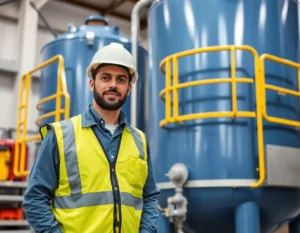Stainless steel, known for its corrosion resistance and durability, is a special alloy composed of a minimum of 10% to 12% chromium, a key element in metallurgy that gives it its unique properties. But, when it comes to welding this material, several questions and challenges arise.
In this blog, we are going to answer one of the most common questions: How to weld stainless steel? We will explore the two main welding techniques, the essential preliminary steps to ensure a good result, and focus on the specific welding of stainless steel railings and handrails. If you are looking to master the welding process of this versatile material, read on to discover everything you need to know!
Types of welding for welding stainless steel
TIG welding (Tugsteng inert gas) or GTAW welding (Gas Tugsteng Arc Welding) is a gas shielded arc welding, which is characterized by the use of a permanent tungsten electrode (It is a chemical element with atomic number 24. It is a rare metal in the earth's crust for the high temperatures reached by the welder.
This type of welding has a great advantage and it is that more resistant, more ductile and less sensitive to corrosion can be obtained than with other types of welding.
In addition, TIG welding greatly simplifies the welding process of ferrous and non-ferrous metals because it does not need to use deoxidizers, another advantage over arc welding is that it allows clean and uniform welds to be obtained due to the lack of smoke and projections, so the welder you have better visibility over what you are doing.
MIG welding or arc welding is known as inert gas welding., hence its name MIG: Metal Inert Gas. The use of inert gases aims to expel oxygen to prevent oxidation of the material supplied in the welding process.
In this process, the inert gas does not participate in the welding, the gases used are gases without reaction such as: argon, a mixture of argon and oxygen and, less frequently, helium.
This type of welding reduces the amount of toxic gases that are produced in welding, its arc welding allows excellent quality finishes since the arc is protected by a solid electrode wire. If you want to know more about this welding, we invite you to read our blog: MIG welding where we explain what it is, how it is applied, what characteristics it has and what its advantages and disadvantages are.
As we have seen before, both welds are similar since both are arc welding, however, the difference between the two is that TIG welding uses a tungsten electrode while MIG welding uses a metal electrode that serves as a filler in the process. of welding and therefore is consumed and must be replaced, while in TIG welding tungsten is not consumed.
Ensure Professional Results in your Welding Project!
Welding stainless steel requires not only technical skills, but also experience and precision to ensure that the final work is durable, safe and aesthetically flawless. If you have a project in mind or need help with welding structures such as stainless steel railings and handrails, our team of experts is here to help.
Don't risk the quality of your project. Trust professionals who understand the complexity of stainless steel and guarantee optimal results.
Discover our welding services and take your project to the next level.
Preparation of material for welding stainless steel
To weld stainless steel we recommend following the steps below before starting the welding process as this protects the machine and the material to be welded.
- Prepare the pieces: When you are going to weld any type of material, the ideal is to have the pieces ready, short, polished and joined so as not to waste a lot of time performing these tasks when we weld.
- Edge preparation: prepare the edges of the pieces in a fundamental step because this tells you how much material you will have to spend on welding, if it is very wide you will spend a lot and if it is very thin it may burst, it is best to leave a separation the size of the electrode you are going to use.
- Cleaning: When you have the pieces arranged and ready to start welding, it is recommended to give them a final cleaning before starting the process so that it is done satisfactorily.
- Plucking: In this step you must align the pieces and make a point of them so that they do not move from their place, this step improves the manufacturing process.
- Ventilation and smoke control: Ventilation is very important so as not to expose the people who weld to the gases released by the welding in this process.
These are the 5 basic steps to start the welding process, now if we go to the ones that brought us to this blog.
How to weld stainless steel?
We are going to make a general explanation about the welding process of stainless steel railings and handrails as an example.
The welding process with the two types of welding is very similar, both have an electrode that heats up and upon contact with the two pieces previously prepared, it melts the steel creating a cord that joins both pieces, this is for the case of TIG that it does not wear out the tungsten, in the case of MIG welding the metal is the one that melts and for this reason it must be changed when the electrode is exhausted.
Next, I will show you a video on how to weld stainless steel with TIG and MIG welding.
Have Questions? Talk to Our Experts!
We know that every project is unique and may require customized solutions. If you have questions about how to welding stainless steel, you need specific advice or simply want to discuss the details of your project, our advisors are here to help you.
Don't let your questions go unanswered. Talk to one of our experts and receive the guidance you need to ensure your project is executed efficiently and with the highest quality. Contact one of our advisors and start working on the perfect solution for your project. We are ready to help you!



